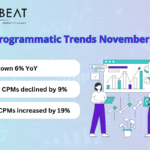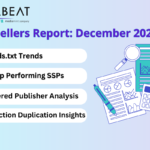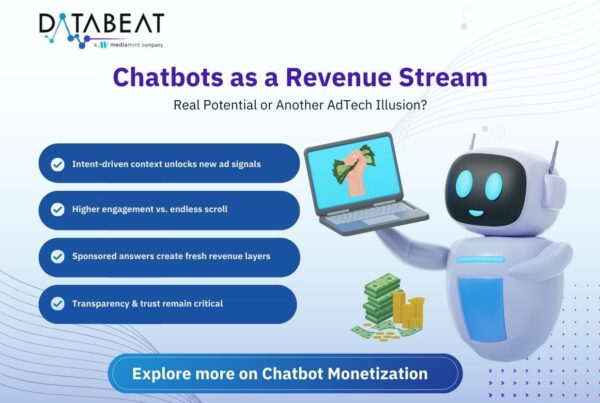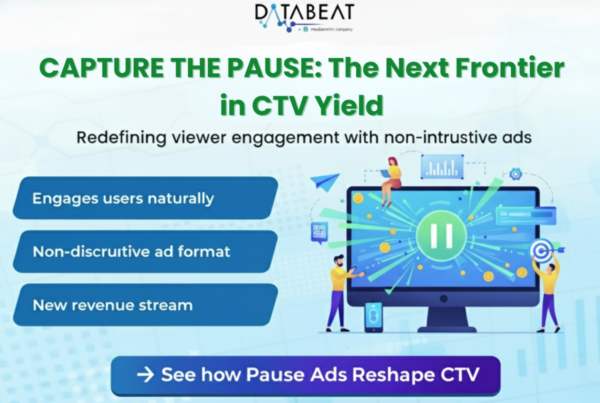
Digital ad purchasing and selling is no longer a brick-and-mortar endeavor. Today, a large portion of these transactions are carried out via a process that we all have come to know as programmatic advertising, a buying, and selling method that is less expensive, more effective, and faster. Today, programmatic advertising continues to gain momentum worldwide, so to truly understand programmatic advertising, it’s essential to get to know one of its key components: A Supply Side Platform (SSP).
An SSP is one of the most effective tools publishers have at their disposal, and when used well, it may provide them with a significant technological edge. Thus, it’s certain that one needs to understand all there is to know about SSPs, including how to utilize them and how to find programmatic SSPs that are the best at what they do. Here is a carefully chosen article to get you going:
Table of contents:
- What is an SSP?
- How does an SSP work?
- Why do you need an SSP?
- What are the features of an SSP?
- Benefits of using an SSP
- Who are the best SSPs in the industry
- How to choose the best SSP?
- Final Thoughts
What is a Supply Side Platform?
A supply-side platform (SSP) is an advertising technology (AdTech) platform used to organize and manage the supply and distribution of ad inventories. SSPs assist digital media owners and publishers sell digital ads in automated auctions.
SSPs are designed to effectively increase the yield optimization of advertising space inventory (including audio, video, display, and mobile) on websites, mobile applications, and other digital platforms to minimize unused space and maximize views. SSPs, in essence, provides publishers the opportunity to sell their inventory to the greatest ad networks and show off their impressions to as many prospective buyers as possible. But that’s not all, they also play a crucial role in the real-time bidding process, enabling publishers to optimize yield by simultaneously connecting their inventory to multiple ad exchanges, ad networks, data-management platforms (DMPs), and demand-side platforms (DSPs). By allowing as many potential customers as possible to buy their impressions, publishers can maximize the revenue they receive for their inventory. For this reason, SSPs are sometimes also referred to as yield-optimization platforms.
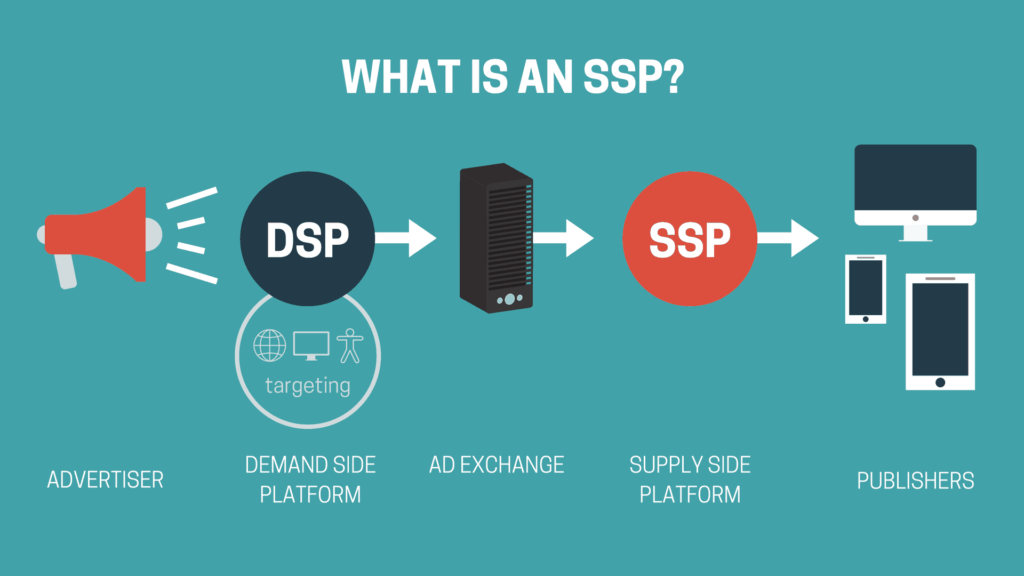
SSP vs DSP?
SSPs are equivalent to DSPs, except they are for advertisers, not marketers. SSPs are used by advertisers to publish their inventory so that it is available programmatically to ad networks, DSPs, and ad exchanges. On the other hand, marketers employ DSPs to programmatically buy advertising from multiple ad exchanges and ad networks.
How does an SSP work?
SSPs link with various demand-side platforms (DSPs) using programmatic advertising technology and resources to assess advertisers, assess publishers’ overall inventory, define the bidding range, and then propose the best fit for each ad space. Using SSPs Publishers can target ads at granular levels, for instance by the advertiser, ad format, audience, geo, floor, and others. Publisher inventory is made accessible to purchasers by SSPs directly or through DSPs, ad exchanges, and agencies.
Once Publishers and SSP have reached an agreement, a code is placed on Publisher’s website to let SSP receive requests whenever a person accesses the page. This request will include details such as the device kind, geolocation, ad slot size, and user cookie id.
Here’s a brief overview of how publishers use SSPs to sell their inventory during RTB:
- A publisher puts their accessible ad inventory on an SSP.
- Each time the publisher’s webpage loads, an ad request is delivered to various ad exchanges, DSPs, either directly from an SSP or to an SSP via the publisher’s ad server.
- In the case of RTB media buys, various DSPs would place bids on the impression the publisher offers (as shown in the image above).
- The winning bid is then delivered to the publisher’s website via the SSP and displayed to the visitor.
Why do you need an SSP?
A supply-side platform performs a critical function for digital advertisers and publishers. Without it, publishers would only be able to accept a small set of advertisers since it would be impossible to review so many bids manually. Other challenges of not using an SSP include the late 2000s introduction of real-time bidding, the rapid development of programmatic advertisements, and now intelligent ad targeting. And yet SSP technology has advanced significantly in recent years. Let us now look at some of the key features of a supply-side platform.
What are the features of an SSP?
- User interface – allows publishers to use SSP to their advantage.
- Analytics and reporting – enables publishers to get complete transparency regarding the success of their inventory through analytics and reporting, including fill rates, clicks, and impressions.
- Header bidding – The majority of SSPs have header bidding capabilities, enabling publishers to manage their header bidding wrappers and demand partners as well as receive bids from various DSPs.
- Yield optimization – aims to boost the publisher’s revenue by improving fill rates, setting floor prices, and managing auction mechanics.
- Inventory and campaign management – allows publishers to manage different types of inventory and block certain types of ads
- Real-time bidding – identifies the bid range and considers all offers to choose the most reasonable a in nd suitable buyer.
- Bidding for the best ad space – the bidding criteria to reflect market demand, particularly when there is excessive competition for a finite amount of advertising space.
What are the Benefits of using an SSP?
- Fill Your Ad Slots: Increasing your website’s fill rate is one of the most beneficial things SSP advertising can do for it. An indicator of whether an advertisement place is frequently occupied or unoccupied is the fill rate. You can gain more money when the site’s ad inventory is filled because more impressions are being bought.
- Opens Up Your Market of Potential Buyers: When you go from an ad agency with a few brands to having an open market of potential buyers, ads get filled faster. This brings us back to the most important service SSP can provide for you: filling your ad spaces. It also enables you to establish the standards for your adverts and broaden your advertising pool. You no longer need to pool from well-known businesses or local marketing. The optimal advertisement will be chosen by SSP automatically for your viewer.
- Set “Price Floors”: A “price floor” allows you to set a minimum amount to be paid for each ad space. To maximize your income, any customers who desire to spend less than that amount will immediately be screened away. The highest bidder who exceeds the limit at which you value your ad spaces is chosen by SSP advertising. To maximize your ad slots you can change “price floors” based on which page the advertisement will appear on.
- Selects Best Ad, Not Highest: SSP chooses the highest-bidding ad that is most appropriate for each viewer. The software won’t choose a pointless advertisement just because it received the highest offer. It takes the information given and applies it to give your viewer the best advertisement experience on your site.
- Limits Ad Impressions: As mentioned above, SSP selects the best ad, but there’s a limit on how often a viewer can see the same or similar advertisement. By capping the ad frequency it helps the viewer to stay satisfied. Additionally, it guards against the publishers’ adverts being annoying.
Some of the well known SSPs in the market:
Google AdExchange | Xandr | Magnite | Pubmatic | OpenX | IndexExchange
How to Choose the Best SSP?
- Easy integration: It must have an ad server designed for easy integration with new demand platforms. It’s critical to monitor changes since publisher gets different offers from various ad networks and ad agencies and these demands frequently vary. You want it to search for high-quality demand sources.
- Demand: Publishers should pick an SSP that can provide appropriate demand and high fill rates. For instance, if a website sells news, and 60% of its video inventory is in the UK, one must pick an SSP with strong video demand from UK consumers who own news-related brands.
- Real-time: Use a platform that focuses on real-time statistics, which means using granular and updated real-time figures.
- Simplicity: You shouldn’t employ a new developer to handle checking and troubleshooting. The publisher should choose one that provides a simple implementation process.
- Comprehensive: You need the option of adding header bidding that integrates with tags. For example, Publift uses Fuse, an all-in-one programmatic advertising solution for publishers. It is driven by a single line of code that assembles all the necessary components to increase programmatic ad income on your website.
Final Thoughts
The ever-expanding range of AdTech platforms and elements in the programmatic ecosystem is extremely successfully handled programmatically by SSPs. Especially when handling many ad networks and their various criteria and restrictions, SSPs assist publishers in managing the complexity and unpredictability of the programmatic ad-buying process. It enables higher-quality user experiences and enhances the quality of interactions between buyers and publishers. A completely automated platform is necessary to change fill rates, yields, price floors, and brand safety.
We hope that this article had all the answers to your questions on SSPs.


